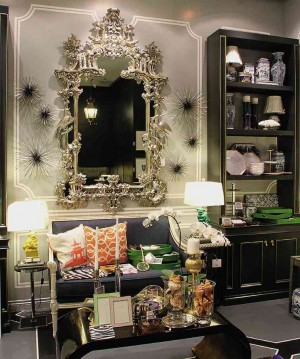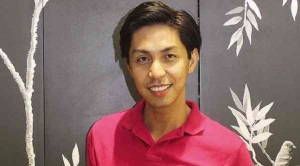It only took a distinct perspective, a flair for style, well-composed vignettes and engagement with his Instagram followers that got fashion journalist Blue Carreon into retail.
When he opened his 35-sqm store, Blue Carreon Home at Century City Mall, friends from the local media made a beeline for interviews and pictorials.
“I was going to pitch to Forbes.com how Instagram got me to open my own store,” says Carreon, a fashion columnist for the South China Morning, Forbes.com and Huffington Post.
The store is a collection of functional and decorative objects for the home. He designed the furniture and put them under his brand name Blue Carreon Home, while the accessories are sourced from India, China and America.
His vision is to share his sensibilities through his designs. “My aesthetic is classic with a twist,” Carreon says.
He points to a square mirror, framed with black metal that is an abstraction of the solihiya, the traditional cross-weaving pattern found in local furniture.
New word of mouth
When Carreon was renovating his apartments in Makati, Midlevels Hong Kong and Midtown Manhattan, he met various suppliers, manufacturers and visited trade shows. He would post the way he styled his three apartments.
Followers on his personal Instagram account (@bluecarreon) would always comment or ask where he sourced his décor. His personal account served as a documentation of his travels, homes and lifestyle.
“People appreciated my postings and wanted to emulate how I decorated,” he says.
In the Philippines, however, he found it challenging that he couldn’t find objects that suited his taste. He realized that the market needed more options. After much thought, he bravely booked a space at the Century City Mall, thanks to his friend, Jackie Cohen, wife of Century Properties executive vice-president for sales and development, Jose Marco Antonio. Last December, Carreon made a dry run by holding a trunk show at his condominium. When he posted Indian-made iron and brass sea urchins for wall décor and the fu dogs from China, visitors came and snapped them up.
Weeks before the mall opening last Feb. 17, Carreon would post photos of the store in various phases of construction. “When I did the big reveal, there was excitement,” he recalls. Carreon received over a hundred likes, the biggest number so far, which is modest compared to other people’s accounts.
He then opened another Instagram account for the store (@bluecarreonhome) which is picking up. At the onset of the store opening, Carreon posted a brass cachepot in his home. The next day, a follower called the store to reserve one. That customer displayed it on a table setting and captured it on Instagram. The posting drew another follower to the store.

THE FOCAL points of the setting: the hand-carved mirror with silver-gilt finish and the seater with imported upholstery.Photo by Nelson Matawaran
Hashtags
“Instagram is the new word of mouth. The impact is exponential. People would Instagram and their followers would see it and come here,” says Carreon.
Recently, a movie director came all the way from Quezon City to buy a faux coral from China, which he saw on someone’s Instagram.
Carreon doesn’t do anything differently in the social media marketing. He doesn’t do anything to enhance the photos. “It’s more of arranging the objects according to design principles.” he says. “Social media is such a full-time job.”
Images are posted three to four times a day, with morning as the best time to get results. He uses the trending hashtag #bluecarreonhome for trendspotting and connecting with other users.
“It’s my research on who have been to the store. I find out how they styled the pieces which they bought at their own home,” Carreon explains. He returns the attention by acknowledging their posts.
“Customers give the décor their own spin. They make a nice table setting with our table accessories or people would Instagram their dogs with our dog toys. A lot of them emulate how we group the blue-and-white vases,” he observes.
People shots are also popular. Carreon would post photos of himself fixing up the store. “They like it that I’m hands-on,” he says.
His manager and two sales associates are dressed in Carreon’s signature weekend look—a checkered shirt, khakis and Converse sneakers. They’ve become quite known to the Instagram followers. When American designer Kim Seybert made a store visit, customers came to buy her melamine plates and tableware the next day.
On continuously enhancing his postings, Carreon explains, “Like my business, the growth is organic. It will improve as we go along.”
Destined as a brand
Becoming an entrepreneur wasn’t in his plan despite having a business degree from the University of the Philippines. He spent a year at the Philippine School of Interior Design then went to Parsons School of Design to study fashion merchandising. He then got a scholarship at the International Academy of Design in Toronto.
His first job was fashion editor for Philippine Tatler although he did more articles on design and society. Hong Kong Tatler was impressed with his work and invited him to join the publication. His work took him to cover the fashion shows in Milan, Paris and New York where he developed a network of celebrity and well-placed friends.
Weary of the Hong Kong’s pollution and cramped apartments, he moved to Singapore where he worked as executive editor for August Men. He was then pirated to launch and spearhead Amica, Italy’s largest-selling women’s magazine.
Wanting a change of atmosphere again, he moved to Hong Kong where he was invited to write a fashion column for the South China Morning Post. Forbes.com had been following his column and invited him to write about interviews with designers for a column Conversations. As a result, Carreon inked a two-book contract with Sky Horse Publishing. By yearend, he will be launching a coffee table book, “Conversations,” a compilation of his Forbes.com interviews with such personalities as Michael Kors, Donna Karan, Jonathan Adler and Kelly Wearstler.
He got the nod from friends such as socialite-turned-designer Tory Burch and cosmetics heiress Erin Lauder. They said his name Blue Carreon was meant to be a brand.
When Carreon started a furniture line made in Cebu under his name, friends such as designer Fiona Kotur warned him about the challenges of manufacturing.
Even to start the business had its difficulties. “There is a lot of paper work involved in the Philippines. You need a lawyer to come up with the bylaws for a corporation and apply for permits. In opening a bank account, there are many requirements and signatories. I plan to expand in the US. I did everything online. You only need proof of registration of business and one ID,” he says.
The business has taught him to plan in advance such as ordering the Christmas collection in the summer. He adds, “Being your own boss is hard work. It means more responsibilities not just to yourself but to people you employ. The work never ends from human resources, logistics, and inventory. I’m always working even on weekends.”
Who reads the bottom line?
“My partner. He’s into finance. He’s got the Excel files,” replies Carreon.
He considers his first venture in Makati as an educational platform. His long-term goal is to have the Blue Carreon Home furniture carried in New York and Hong Kong. He also plans to open a store in the Hamptons, an affluent and recession-proof resort community in New York.
“I would love to bring Philippine design there. The rattan, shell and bamboo products would do well there because they are not easily available.”


